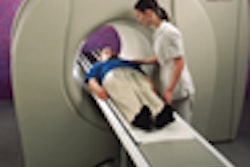Detecting nodal metastases is essential for evaluating patients with melanoma. While modalities from US to CT to MRI can detect morphologic changes in lymph nodes, only FDG-PET can indicate the presence or absence of malignancy, thanks to a high affinity for melanoma. A study in the September Journal of Nuclear Medicine said FDG-PET was reasonably sensitive and specific for the detection of lymph node metastases, yet it failed to adequately detect microscopic disease, and produced some false-positive results.
Study authors Flabio Crippa, Monica Leutner, and colleagues from the Istituto Nazionale per lo Studio e la Cura dei Tumori in Milan, Italy set out to assess the accuracy of FDG-PET in the diagnosis of lymph node metastases, and determine the smallest volume of disease the modality could detect.
The researchers studied 38 patients (mean age, 47) with a current diagnosis of nodal metastases in at least 1 lymph node basin. A total of 56 basins included 2 parotid, 7 cervical, 12 axillary, 13 pelvic, 21 inguinal, and 1 popliteal. All sites were studied with FDG one to three days before surgery, and all underwent dissection.
A 4096 Plus scanner (GE Medical Systems, Waukesha, WI), was used to produce images consisting of 15 simultaneous contiguous axial slices (6.5 mm thick). Transmission scans were acquired before FDG injection with a rotating GE rod source to correct attenuation of the body regions, followed by 20-min. static emission images 45-60 minutes after injection, according to the authors.
Attenuation-corrected emission images were reconstructed by filtered back projection. Average transaxial and axial resolutions were 7.3 mm and 5.3 mm, respectively, corresponding to a volumetric resolution of 0.28 cm, the authors noted. Two experienced nuclear medicine physicians interpreted the results based on visual evaluation of uptake relative to the surrounding background, and without knowledge of the histopathologic findings at surgery.
Histopathology revealed 37 lymph node metastases in 37 basins, while PET found at least one focus of uptake in 35 basins. FDG-PET correctly identified 16 of 19 basins that were negative at histology. Yet there were 2 false-negative PET results that showed very limited metastases at histology, the authors noted, with one embolic metastasis of 0.09 mm in one patient, and pleuriembolic metastases smaller than 0.04 mm in a pelvic lymph node undetected with PET.
There were also 3 false-positive results "despite exclusion of patients who, through clinical examination, sonography or CT, were found to be free of regional lymphadenopathy ... without any clinical or histological explanation," they wrote. PET found 100% of the metastases > 10 mm, and 83% of the metastases from 6-10 mm, but only 23% of metastases 5 mm or smaller.
"Dedicated PET scanners with a higher resolution than ours may increase the potential to detect metastatic lymph node disease...." they wrote.
The technique showed a high sensitivity (93%-100%) in the detection of metastatic nodes with tumor involvement of more than 50%, or capsular infiltration.
FDG-PET has advantages over other nuclear medicine techniques such as radiocolloid lymphoscintigraphy, which is technically demanding, more invasive, and applicable only in surgery. Another technique recently proposed for detecting metastases, T1 scintigraphy, has a lower sensitivity and higher false-negative incidence than FDG-PET, they wrote.
On the other hand, FDG-PET is noninvasive, highly standardized, and can be applied to any stage of disease management, according to the authors. Its accuracy in the study group was greater than 90% for the detection of lymph node metastases, even when the nodes were of normal size. But results vary among studies, they wrote, which are generally flawed due to the heterogeneity of patient characteristics and the methods used to assess the nodal status.
"In fact, histology has not always been used as the gold standard; FDG-PET has been compared with conventional imaging techniques or with clinical follow-up," the authors wrote. "Therefore, the true false-positive and false-negative rates for FDG-PET of the lymph node metastases are often not well defined, and the lower limit of resolution of the technique... has not been determined," they wrote.
FDG-PET has an acceptable sensitivity and specificity for detecting lymph node metastases in patients with melanoma, they concluded. "However, even if FDG-PET can detect small subclinical macroscopic lesions, it has no acceptable sensitivity in the detection of subclinical microscopic disease. Our results encourage the use of FDG-PET in melanoma patients with doubtful lymph node involvement."
By Eric Barnes
AuntMinnie.com staff writer
October 16, 2000
Related Reading
Ultrasound detects melanoma metastases missed by clinical exam, June 2, 2000
Let AuntMinnie.com know what you think about this story.
Copyright © 2000 AuntMinnie.com




















